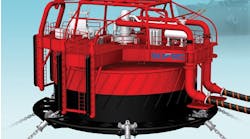Offshore staff
MUNICH, Germany -- Siemens Water Technologies is launching a new, compact oil/water separation unit for the offshore oil and gas industry. The new Vorsep system incorporates several methods for removing oil from produced and wastewater streams before they are discharged, reused, or injected. The unit reduces inventoried water in the system and is therefore compact and lightweight, the company says.
The Vorsep system can reduce the residence time necessary for separation by 80% or more, relative to standard flotation systems, the company says. This separation efficiency results in reducing the inventoried water in the system by the same percentage as the residence time, resulting in a system optimized for footprint and weight without reducing effectiveness.
As oily water feed enters the Vorsep unit, it flows through a Brise pump installed in the inlet piping to the vessel. The pump initiates dissolved gas mixing in the oily water. The gas-filled feed is accelerated by angled pipes to generate a vortex-induced separation of the incoming liquid. This motion created in the Vorsep system by the inlet angle results in accelerating the separation forces, improving removal efficiency, the company says.
As the oil droplets grow due to the voraxial motion, the dissolved gas is released, forming micro-bubbles that aid and accelerate flotation of the oil to the surface. The rising oil droplets coagulate at the surface and are skimmed from the water. Clean effluent flows from the Vorsep system ready for discharge, reuse, injection, or further treatment.
The Vorsep system is designed to handle standard operating environments or environments that experience extreme movement, such as floating platforms (spar, TLP, FPSO).
Extreme movements in these applications result in potential turbulent environments within the vessel causing excess water to be removed with the oil if based on a standard oil removal system. Siemens' design incorporates the proven "head-in-head" arrangement that reduces turbulence at the removal point from the vessel by reducing the surface area; reduces the water carried with removed oil; and maximizes oil removal efficiency.
01/20/2009


